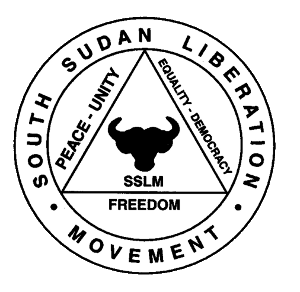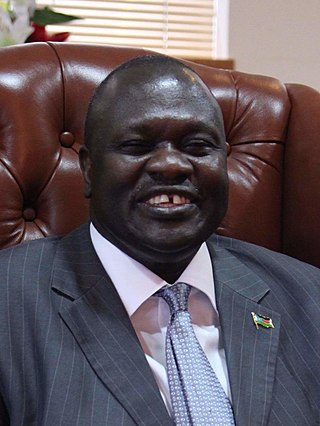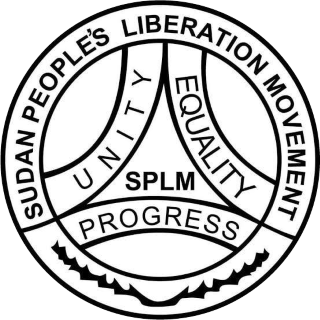Related Research Articles

The South Sudan Liberation Movement (SSLM) is an armed group that operates in the Upper Nile Region of South Sudan. The group's creation was announced in November 1999 by people of the Nuer ethnicity who were in both the rebel Sudan People's Liberation Army (SPLA) and the government-allied South Sudan Defence Forces (SSDF) gathered in Waat. The SSLM was declared to be unaligned in the Second Sudanese Civil War, then entering its sixteenth year. The name "South Sudan Liberation Movement" was decided upon the next year, borrowing from the earlier Southern Sudan Liberation Movement, which existed in the 1980s.

Bor is a historic city in South Sudan’s central region, being the epicenter of national liberation revolution with multiple landmarks that tells the story. In Malual-Chaat barrack, statues of liberators and destroyed weapons are conserved and exhibited at historical heritage site. It has also served as the headquarters of Jonglei state. The city is situated on the east side of the White Nile at the southern extent of the sudd, South Sudan's vast central wetlands.

Riek Machar Teny Dhurgon is a South Sudanese politician who served as the First Vice President of South Sudan.

The Sudan People's Liberation Movement is a political party in South Sudan. It was initially founded as the political wing of the Sudan People's Liberation Army in 1983. On January 9, 2005 the SPLA, the SPLM and the Government of Sudan signed the Comprehensive Peace Agreement, ending the civil war. SPLM then obtained representation in the Government of Sudan, and was the main constituent of the Government of the then semi-autonomous Southern Sudan. When South Sudan became a sovereign state on 9 July 2011, SPLM became the ruling party of the new republic. SPLM branches in Sudan separated themselves from SPLM, forming the Sudan People's Liberation Movement–North. Further factionalism appeared as a result of the 2013–2014 South Sudanese Civil War, with President Salva Kiir leading the SPLM-Juba and former Vice President Riek Machar leading the Sudan People's Liberation Movement-in-Opposition.

The SPLA-Nasir was a splinter faction of the Sudan People's Liberation Army (SPLA), a rebel group that fought in the Second Sudanese Civil War. Originally created as an attempt by the Nuer tribe to replace SPLA leader John Garang in August 1991, it gradually became coopted by the government. The break away of Riek Machar from SPLM/A resulted in Nuer ethnic group massacring Garang's ethnic Dinka from Bor in the Bor massacre in 1991. This split resulted in the 1994 National Convention of New Sudan in Chukudum.

Gabriel Gatwech Chan, more commonly known by the nickname Tang-Ginye or Tanginye meaning "long pipe", was a Nuer and a commander in various primarily Nuer rebel militias in South Sudan. General Tanginye led a southern border militia allied to the Khartoum government during Sudan's civil war. Members of the Sudanese armed forces loyal to Tanginye in Malakal clashed with the Sudan People's Liberation Army (SPLA) in 2006, killing about 150 people, and in 2009 in breach of the peace deal. In April 2011, clashes between his militia and the SPLA in the state of Jonglei killed at least 57 according to government officials. Shortly thereafter, Tanginye surrendered to SPLA forces and was placed under house arrest in Juba awaiting charges against him. During the South Sudanese Civil War, he allied with the SPLA-IO and later Lam Akol's militia, a Juba linked rebel group called the National Democratic Movement (NDM) and became its chief of staff. In January 2017 he visited a NDM-allied group, the Tiger Faction New Forces, in the Hamra area in the northern Upper Nile. In course of this visit, the Tigers were attacked by SPLM-IO-affiliated fighters belonging to the militia of John Uliny, and Tanginye was killed alongside most of the Tigers.
Peter Gatdet Yak or Peter Gadet was a Sudan People's Liberation Army (SPLA) general who became the leader of the South Sudan Liberation Army (SSLA), a rebel movement in South Sudan.
The history of South Sudan comprises the history of the territory of present-day South Sudan and the peoples inhabiting the region.

Human rights in South Sudan are a contentious issue, owing at least in part to the country's violent history.
Kerubino Kuanyin Bol was a Sudanese rebel leader who was one of the founders of the Sudan People's Liberation Movement (SPLM) and one of the leaders of the Sudan People's Liberation Army (SPLA) during the Second Sudanese Civil War and was said to have fired the first shot in the conflict.
Ethnic violence in South Sudan has a long history among South Sudan's varied ethnic groups. South Sudan has 64 tribes with the largest being the Dinka, who constitute about 35% of the population and predominate in government. The second largest are the Nuers. Conflict is often aggravated among nomadic groups over the issue of cattle and grazing land and is part of the wider Sudanese nomadic conflicts.

The Nuer White Army, sometimes decapitalised as the "white army", is a semi-official name for a militant organisation formed by the Nuer people of central and eastern Greater Upper Nile in modern-day South Sudan as early as 1991. According to the Small Arms Survey, it arose from the 1991 schism within the Sudan People's Liberation Movement/Army (SPLM/A) for the dual purpose of defending Nuer cattle herds from neighbouring groups and fighting in the Second Sudanese Civil War between the SPLM/A and the Sudanese government.

The South Sudanese Civil War was a multi-sided civil war in South Sudan between forces of the government and opposition forces. In December 2013, President Salva Kiir accused his former deputy Riek Machar and 10 others of attempting a coup d'état. Machar denied trying to start a coup and fled to lead the Sudan People's Liberation Movement-in-Opposition (SPLM-IO). Fighting broke out between the Sudan People's Liberation Movement (SPLM) and SPLM-IO, igniting the civil war. Ugandan troops were deployed to fight alongside the South Sudanese government. The United Nations has peacekeepers in the country as part of the United Nations Mission in South Sudan (UNMISS).
The 2014 Bentiu massacre occurred on 15 April 2014 in the town of Bentiu, in the north of South Sudan, during the South Sudanese Civil War. The attack has been described by The Economist as the "worst massacre" of the civil war.

The Sudan People's Liberation Movement-in-Opposition, also known as the anti-governmental forces (AGF), is a mainly South Sudanese political party and rebel group that split from the Sudan People's Liberation Movement in 2013, due to political tensions between President Salva Kiir and Vice President Riek Machar over leadership of the SPLM. Tensions grew between forces loyal to Kiir and Machar and South Sudan plunged into the South Sudanese Civil War.
Simon Gatwech Dual is a Sudanese rebel Major General who was born in around the late 1930s in what is today Uror County, Jonglei state, South Sudan.
Mathiang Anyoor, also spelled Mathiang Anyur, also known as Dot Ke Beny, is a Dinka-affiliated militia group in South Sudan. Originally an ad-hoc volunteer force founded in 2012, the militia was transformed into a private army to protect President Salva Kiir Mayardit and army chief Paul Malong Awan. However, the South Sudanese military (SPLA) claims that it is just another battalion. Much of the ethnic violence against non-Dinkas in the South Sudanese Civil War is attributed to the militia.
Peter Par Jiek was a brigadier general of the Sudan People's Liberation Army (SPLA), and veteran of the Second Sudanese Civil War. In the course of that conflict, Par fought under Riek Machar with several rebel and pro-government groups, and eventually became a powerful militia commander in Unity State. In that region, he established his own fiefdom and gained some notoriety for his rivalry with another rebel leader, Peter Gadet. Even though he had followed Machar during the whole Second Sudanese Civil War until 2005, Par sided with President Salva Kiir Mayardit upon the outbreak of the South Sudanese Civil War in 2013. Leading pro-government counter-insurgency forces in Wau State since 2014, Par was eventually ambushed and killed by SPLM-IO rebels loyal to Machar in 2017.
The disarmament of the Lou Nuer was a forcible disarmament campaign undertaken by the SPLA in Southern Sudan in December 2005. While other groups had been peacefully disarmed, the Lou section of the Nuer in Northern Jonglei State refused to comply. The SPLA organized a force under Peter Bol Kong to forcibly disarm the Lou Nuer, whose White Army resisted until a defeat in the battle of Motot, after which they fled the area.
The Battle of Bor was one of the first battles of the South Sudanese Civil War, consisting of a series of clashes for the city of Bor, the capital of Jonglei State, between the SPLA and SPLA defectors under Peter Gadet, part of the force that would become the SPLA-IO. The city changed hands four times between December 18, 2013 and January 18, 2014, ultimately leaving the SPLA in control.
References
- ↑ Richard Cockett Sudan: Darfur and the failure of an African state. 2010. Hobbs the Printers Ltd, Totton, Hampshire. ISBN 978-0-300-16273-8
- ↑ Copnall, James. "South Sudan's massacre among many". Al Jazeera . Archived from the original on 2020-12-13. Retrieved 2021-12-13.
- ↑ "South Sudan: White Army 'abandons war march' on Bor town". BBC News . 29 December 2013. Retrieved 29 December 2013.
- ↑ "Tangled web of South Sudan politics spells bleak future". bbcnews.com. 19 December 2013. Retrieved 20 December 2013.
- 1 2 "Riek Machar in tears as he admits to 1991 Bor massacres". thelondoneveningpost.com. 16 August 2011. Archived from the original on 14 May 2019. Retrieved 20 December 2013.
- ↑ "Reclaiming the past in Southern Sudan". bbcnews.com. 1 July 2006. Retrieved 20 December 2013.
- ↑ "South Sudan VP confirms apology for Bor Massacre". sudantribune.com. 4 April 2012. Retrieved 20 December 2013.
- ↑ You Tube Channel 4 UK TV Report by Mark Stucke Nov 1991
- ↑ Sudan Tribune August 31, 2007 http://www.sudantribune.com/spip.php?article23545. By Gatkuoth Lam. Dinka Bor Massacre